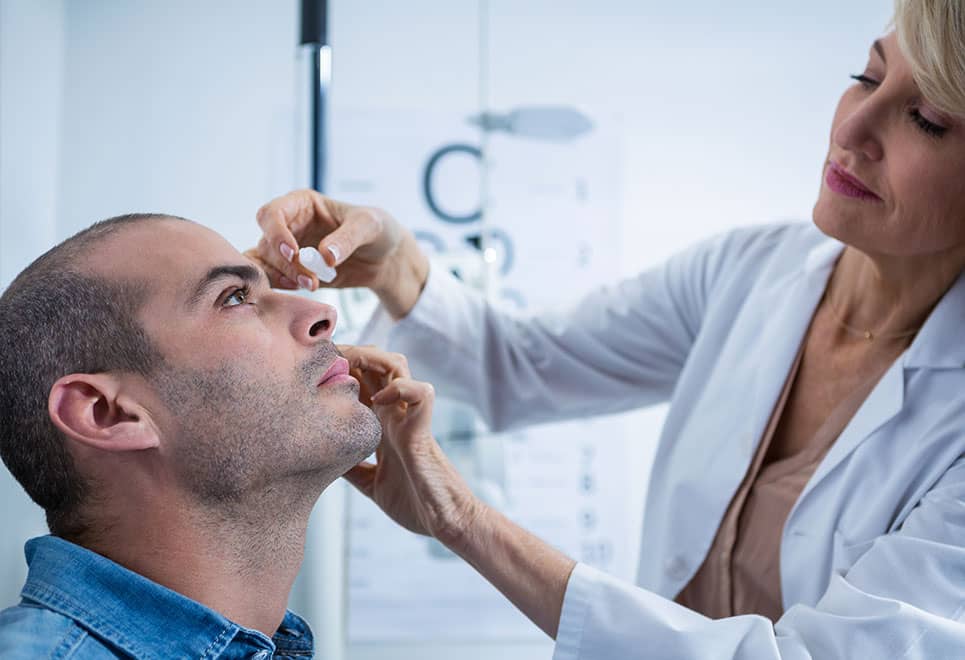Over time, our natural lenses in our eyes become less flexible, making it difficult to focus and see up close, leading to clouding of the eyes and reduced attention. This can hinder daily activities and may even cause discomfort due to glare effects on your vision, affecting your ability to see objects clearly. Refractive Lens Exchange, a type of cataract surgery pioneered by Dr. Olkowski, MD, can help make your world look more crisp and clear without having to rely on readers or bifocals, minimizing dependence on corrective eyewear.
This procedure is a choice alternative to LASIK surgery and other laser vision correction technologies for those who may not meet the criteria for refractive surgery due to material reasons such as cornea thickness. Additionally, it may reduce the risk of complications related to retinal detachment and lens implantation in some patients, including issues like tissue damage, surface infections, or damage to the corneas. The cost of laser surgery can be higher than other types of surgeries, but considering the pros and cons, the difference in someone’s life after the treatment is worth considering. Advances in technology and insurance coverage, as well as FDA approval, have further improved accessibility to this life-changing procedure for various levels of patients. The success and popularity of this procedure are opening up a window of opportunity for many, however, it may not be suitable for everyone.
Dr. Olkowski, a board-certified ophthalmologist, and his team at EyeSight Hawaii perform the RLE procedure at their state-of-the-art center, which allows surgeons to safely remove and replace the dysfunctional lens in your eye without error. They use premium multifocal intraocular lenses (IOL) along with the most advanced technology to ensure great results for their patients, allowing them to see far and near without glasses or contacts.
The surgeon’s experience, best practices, and patient care are crucial to successful outcomes, as is the need for a thorough consultation to determine the best course of action based on the patient’s individual needs. In their practice, they constantly deal with various types of issues and are prepared to tailor the treatment to each case, taking into account specific conditions and visual needs, while ensuring proper attention is given to prevent any infection.

WHAT IS THE RLE PROCEDURE?
Refractive Lens Exchange (RLE) is a process that removes the aging, dysfunctional lens and restores vision to a level that often cannot be achieved with LASIK or PRK procedures. Patients over 45 will often begin experiencing poor quality near, intermediate, and even distance vision due to the natural aging of the lens, called “presbyopia”. This age-related change eventually ends up causing cataracts, vision loss, and potentially even glaucoma in some cases, which can affect the retina as well.
But many patients suffering from myopia (nearsightedness) or hyperopia (farsightedness) with astigmatism endure gradually worsening vision during their 40’s, 50’s, and beyond, in addition to experiencing halos around lights and issues on the surface of their eyes from traditional LASIK surgery. Instead of waiting years for a cataract to fully develop, RLE permanently replaces the dysfunctional lens in a 10-15 minute painless procedure, allowing patients to enjoy the renewed quality and success of their vision.
New technology intraocular lens implants (IOLs) can offer visual freedom by restoring distance, intermediate, and near vision as part of the treatment, with the added advantage of potentially reducing dependency on glasses or contact lenses. These implants, also known as ICL, can assist patients with various eye conditions in accomplishing everyday tasks more efficiently.

BENEFITS OF Refractive Lens Exchange
In Refractive Lens Exchange (RLE), the eye’s natural lens is replaced with an artificial lens implant through a lens replacement surgery performed by an experienced eye surgeon. This ophthalmology procedure provides an indication that refractive errors such as nearsightedness or farsightedness can be corrected without needing glasses or contact lenses.
The surgery involves the removal of the iris and replacing it with an artificial lens implant inside a bag, ensuring you regain points of vision that may have been lost due to the condition. Studies have shown the costs and benefits of RLE for individual patients.
Instead of waiting years for a cataract to fully develop or presbyopia to worsen dramatically, RLE surgery permanently replaces the dysfunctional lens in the eye in a quick, painless outpatient procedure. And, with a range of premium replacement lenses to choose from, RLE can offer freedom from corrective eyewear by improving distance, intermediate, and near vision with a greater degree of depth perception, benefitting many individuals.
In many cases, people with developing cataracts or severe presbyopia have to struggle with the hassle of wearing reading glasses to see small print or just suffering with low vision until their cataracts reach a certain point. Today, we can offer patients exciting new options for long-term vision, with a simple procedure known as Refractive Lens Exchange, or RLE. This transformative solution lies at the intersection of state-of-the-art technology and medical education.
YOUR RLE CONSULTATION
The first step in your journey to improved vision at Eyesight Hawaii is your consultation with an eye doctor. Your consultation will determine if you are a good candidate for Refractive Lens Exchange. An RLE consultation includes:
- A refractive and dilated eye exam
- A discussion of your eligibility for RLE
- Information about the benefits and risks of RLE with premium IOLs
- An opportunity to ask questions and address any concerns

PREPARING FOR REFRACTIVE LENS EXCHANGE
You will be instructed to stop wearing soft contact lenses three days to a week before your surgery to avoid any complications, such as capsulotomy or endophthalmitis, during the procedure.
Makeup, perfume, cologne, and body spray interfere with the laser and medications used in the procedure. You will be advised not to wear any of these products on the day of your procedure.

What Patients Say

WHAT HAPPENS DURING THE RLE PROCEDURE?
RLE is a 10-15 minute procedure where the eye is numbed with topical anesthesia and a 2-millimeter opening is made at the edge of the cornea. Through this small incision, a pen-like instrument called a phaco tip is placed into the eye to remove the dysfunctional lens, leaving the eye’s natural lens capsule in place. Then, through that same small incision, an intraocular lens (IOL) implant is placed into the capsule and rotated into position. There is typically no patching required for surgery with topical anesthesia. We expect our patients to have their vision restored by the next day with a smooth recovery process.
Contact Us Today
RLE is a great option for people suffering from DLS (Dysfunctional Lens Syndrome) or early cataracts, the result of a natural aging process that reduces visual clarity and focusing power and makes it harder to read up close or in low light situations. If you hear yourself complaining about how old you feel because you can’t see anymore, you’re probably a candidate.
The eye doctors at EyeSight Hawaii in Honolulu, HI, and Maui, HI, have the experience and knowledge to help. Make an appointment online or call our office to schedule a consultation today!

